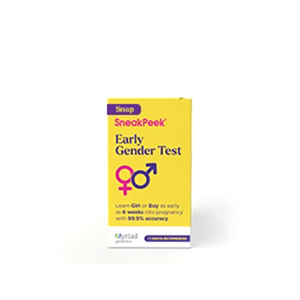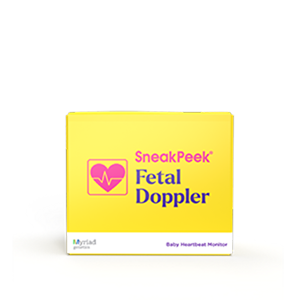Published on December 2nd, 2020 and Updated on January 15th, 2024
Check out SneakPeek Gender Test to find out your baby’s gender as early as 6 weeks at over 99% accuracy1!
From milk to mac & cheese, dairy products define childhood favorites. We all know the familiar saying: milk—it does a body good.
But does it do every body good?
Dairy intolerance, also known as lactose intolerance, affects 65% of the human population after infancy. Thankfully, dairy intolerance during infancy is extremely rare. But when it does happen, feeding a baby who suffers from dairy intolerance can pose a bit of a challenge for parents. That’s because dairy intolerance encompasses all types of dairy foods, from cow’s milk based baby formulas to what’s in breast milk.
#1 Dairy Intolerance is the Body’s Inability to Break Down Lactose
If your baby is dairy intolerant, it’s not the bottle of milk-based formula or the gulp of breastmilk that will cause your child a little tummy trouble, it’s actually just one tiny part of it—lactose.
#2 Lactose is a Kind of Sugar
Lactose is the primary sugar found in dairy products. Your child’s body uses the sugar from lactose and converts it into energy to power crawling expeditions, figuring out fingers, slobbering.
#3 Breastmilk (and Many Infant Formulas) Contains Lactose
Milk contains lactose—whether that milk comes from mom, a cow, a goat, or a sheep.
It’s important to consider and know how many calories your baby needs. If your child is truly lactose intolerant, your doctor will help you create a special elimination diet of lactose-free formulas and supplements to help ensure your baby is getting all the nourishment she needs to grow up strong and healthy.
To help ensure your child stays healthy—and her tummy stays happy—keep an eye on the ingredient labels of any food products. Anything that lists the following ingredients will contain lactose and should be avoided for a lactose-intolerant child:
- Whey
- Curds
- Milk by-products
- Dry milk solids
- Nonfat dry milk powder
Since most baby formula ingredients are milk-based, dairy intolerance in an infant who is fed formula will be spotted just as easily as a dairy intolerance in a breastfed baby.
#4 What Happens When a Lactose Intolerant Baby Drinks Milk
If your baby is dairy intolerant, the process from a sip of milk to a burst of energy can be a little more complex.
Let’s start the journey of lactose with a big gulp of milk—any kind of mammal-sourced milk will do.
So bottoms up, and to the esophagus we go!
First, that swallow of milk moves down the esophagus—the tube that connects your child’s mouth to the rest of his digestive tract—and lands in the stomach. From there, your baby’s stomach muscles mix up the milk with the digestive juices which breaks down food to be absorbed by the body.
Onto the next phase—the small intestine, where things get interesting.
The small intestine is a tract of tubing where water and nutrients are absorbed into your child’s bloodstream to be used throughout the body. Lactose is broken down by a special enzyme located in the small intestine called the lactase enzyme. The lactase breaks lactose down into two sugars that are simpler and much easier to absorb:
- Glucose
- Galactose
But if your baby doesn’t have enough lactase, what happens to the lactose?
Well, it has to get broken down somehow. The lactose goes through the small intestine, into the large intestine, before being broken down in the colon.
From there, a less qualified substance steps in to do the dirty work—the gut bacteria.
Your baby’s gut bacteria helps the body break down food and absorb certain nutrients, and acts as a protective barrier against intestinal infections—and it’s really good at those things!
But breaking down lactose? Not so much.
As the bacteria breaks down the lactose, it produces hydrogen gas—that’s what causes lactose-intolerant babies to have gas, bloating, and cramping. The lactose also draws water into the colon, loosening your baby’s stool and leading to diarrhea.
That’s lactose intolerance!
#5 Several Things Can Cause Lactose Intolerance in Babies
Lactose intolerance comes from a lack of lactase, but hey, where did all that lactase go?
There are a few things that can cause dairy intolerance in babies, including:
- Congenital lactase deficiency – Some babies might be born without any lactase enzymes at all. This is called congenital lactase deficiency. You’ll likely know about this condition as soon as your baby is born and tries her first feeding—the inability to digest milk will be extremely clear.
And by clear, we mean a really messy brown.
Congenital lactase deficiency is caused by a mutation of the LCT gene. The LCT gene tells the body to make lactase. While it’s not clear how many babies are born with this condition, congenital lactase deficiency is a pretty rare condition. Both parents would have to contribute this recessive gene mutation for it to manifest in their child.
- Developmental lactase deficiency – When babies are born a little early, their tummies might need a little time to catch up and grow all the important stuff—like lactase. That’s why preemies—or babies born before reaching full term—may be born with developmental lactase deficiency, a condition in which the newborn doesn’t have enough lactase to digest dairy. Luckily, it’s only temporary. As the baby grows, so do the important stomach enzymes.
- Gastroenteritis – Also known as the stomach flu, gastroenteritis is the inflammation of the stomach lining which can denature—or render ineffective—the enzymes in your digestive tract. That includes lactase. This temporary lactose intolerance is referred to as secondary lactose intolerance. Milk might be a bad idea for your baby after a case of the tummy bug. Luckily, the body will restore its lactase over time.
#6 Dairy Intolerance in Babies Isn’t Common, But Aging May Increase Lactose Tolerance
As mentioned earlier, lactose intolerance isn’t very common in infants. But just because your baby isn’t lactose intolerant now, doesn’t mean she won’t be later. It all goes back to that LCT gene. Over time, that gene can become less active—which is partly why you might not be able to eat as much mac & cheese now as you did when you were a kid.
Some children’s lactose intolerance might kick in when they’re 2 or 3 years old. Or, some children might experience lactose intolerance when they’re in their teens. Just keep an eye on their tummies after pizza night.
#7 Lactose Intolerance versus Milk Allergy – What’s the Difference?
The difference between a lactose intolerance and milk allergy? Lactose intolerance affects the digestive system while a milk allergy involves the immune system. An allergy is a chronic condition in which your child’s body has an abnormal allergic reaction to a usually harmless substance—like milk. When children are allergic to milk products, they’re actually allergic to a particular protein in cow’s milk, not lactose at all.
Milk allergy symptoms also look different than dairy intolerance symptoms. In fact, milk allergy symptoms manifest as typical allergy symptoms, including:
- Hives
- Coughing
- Swelling of the lips, tongue, or throat
- Wheezing
- Vomiting
#8 Signs of Dairy Intolerance in Baby
The more lactose your child ingests, the more your child’s symptoms will be pronounced, including::
- Loose stools
- Gas
- Watery diarrhea and gas
Truly lactose-intolerant babies may also struggle to gain weight and show signs of dehydration due to excess diarrhea.
#9 How Your Baby’s Pediatrician Will Check for Lactose Intolerance
If you’re seeing these symptoms, give your child’s pediatrician a call. From there, lactose intolerance can be tested in one of two ways:
- Hydrogen breath test – When a child is lactose intolerant, his gut bacteria breaks down the lactose instead of the lactase enzyme. A byproduct of that process is hydrogen. Your doctor will have your child breathe into a container that measures breath hydrogen level after either breastfeeding or drinking a milk-based infant formula. If your child’s hydrogen breath levels are higher than normal, he’s most likely lactose intolerant.
- Stool test – Your child’s diaper may be the key to his diagnosis! Your pediatrician may also check the acidity of your child’s stool. Another byproduct of bacteria chowing down on lactose is lactic acid. If your child’s stool is more acidic than it should be, he could be lactose intolerant.
Your doctor may also test for extra milk sugar molecules in your child’s stool. Lactose is a kind of milk sugar found in dairy foods. When a body is lactose intolerant, lactose is broken down later in the digestive processes—pretty much when what used to be food is on its way to being stool.
Because the sugar isn’t broken down until the latest stages of digestion, glucose or galactose molecules will make their exit in the stool before they can be absorbed. That’s why dairy intolerance may create traces of excess sugar in stool.
#10 What Mom Eats Doesn’t Affect Lactose in Breastmilk
If you give up milkshakes and grilled cheese, will breastfeeding your baby still be an option? Unfortunately, the lactose in breastmilk doesn’t come from Mom’s diet. Even if you go dairy-free for years, lactose is an integral chemical component of all mammalian milk varieties.
Saying No to Lactose and Yes to Long-Term Nutrition
Lactose intolerance doesn’t mean your child will struggle to get the nourishment she needs. It just means she’ll need a little more care when it comes to feedings. With some time, research, and help from your pediatrician, you can ensure she’s getting all the vitamins, minerals, and fuel her body needs to grow into her beautiful self.
Navigating the challenges of dairy intolerance in babies can be daunting, but armed with the knowledge about what causes this condition and how to manage it, parents can effectively feed their infants with lactose-free options to ensure their growth and well-being. As much as dairy products play a big role in a child’s diet, remembering that a healthy, happy baby is not defined by lactose intake but by proper nutrition and care can help in dispelling the anxieties associated with baby dairy intolerance.
Sources:
Healthline. Signs and Symptoms Your Baby May Be Lactose Intolerant. https://www.healthline.com/health/baby/lactose-intolerance-symptoms-in-babies
Moms. 20 Things to Know About a Lactose Intolerant Baby. https://www.moms.com/20-things-to-know-about-a-lactose-intolerant-baby/
Healthline. Everything You Need to Know About Glucose. https://www.healthline.com/health/glucose
Kids Health. Lactose Intolerance. https://kidshealth.org/en/teens/lactose-intolerance.html
Harvard Health. Lactose Intolerance. https://www.health.harvard.edu/a_to_z/lactose-intolerance-a-to-z#
Everyday Health. Can You Become Lactose Intolerant Later in Life? https://www.everydayhealth.com/news/can-you-develop-lactose-intolerance-later-life/
Healthy Children. Lactose Intolerance in INfants & Children: Parent FAQs.

Shop Our Products
SneakPeek aims to provide the most accurate and up-to-date information to help our readers make informed decisions regarding their health before, during, and after pregnancy. This article was written based upon trusted scientific research studies and/or articles. Credible information sources for this article are cited and hyperlinked.





